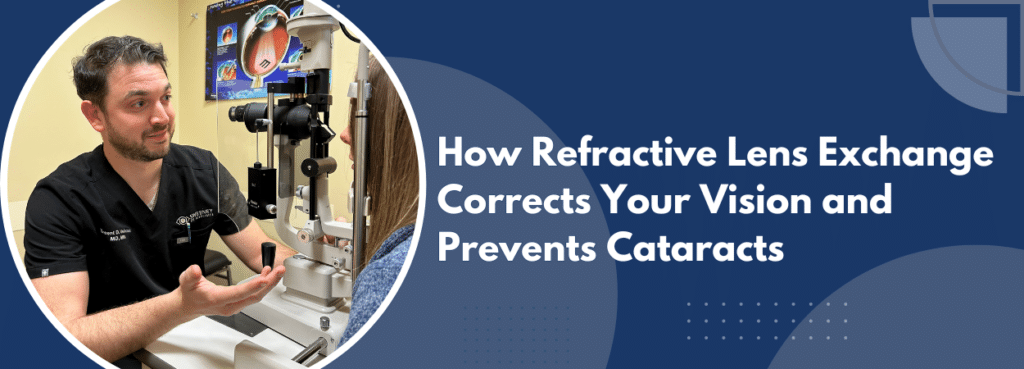Cataracts,Refractive Lens Exchange,Vision Correction

Refractive Lens Exchange (RLE) is a revolutionary procedure that not only corrects your vision but also offers the unique advantage of preventing cataracts in the future. If you’re over 40 and considering options to improve your vision, RLE might be the perfect solution for you. In this blog, We’ll explore how RLE works, who can benefit from it, and why it’s becoming a popular alternative to LASIK, particularly for those concerned about cataracts.
What Is Refractive Lens Exchange?
Refractive Lens Exchange is a procedure that involves removing your eye’s natural lens and replacing it with a premium artificial intraocular lens (IOL). This lens is designed to correct refractive errors such as nearsightedness, farsightedness, and astigmatism. Unlike LASIK, which reshapes the cornea, RLE addresses vision problems by focusing on the lens.
“Astigmatism, farsightedness, and nearsightedness are terms used to describe when someone needs correction to see well, and yes, refractive lens exchange can correct all three. One of the main benefits of refractive lens exchange is that, because you won’t develop a cataract, your vision should remain stable permanently.” Dr. Vincent Venincasa
The Dual Benefit: Vision Correction and Cataract Prevention
One of the standout benefits of RLE is that it not only corrects your vision but also prevents cataracts from developing later in life. Cataracts occur when the natural lens of the eye becomes cloudy, impairing vision. Because RLE replaces this natural lens with an artificial one, the risk of developing cataracts is virtually eliminated.
According to the American Academy of Ophthalmology (AAO), cataracts are one of the leading causes of vision loss in the United States, affecting more than 24 million Americans over the age of 40. By opting for RLE, you’re essentially taking a proactive approach to preserving your eye health for years to come.
Who Is a Good Candidate for Refractive Lens Exchange?
RLE is particularly beneficial for individuals over 40 who are experiencing presbyopia (age-related loss of near vision) and those who are not suitable candidates for LASIK due to severe refractive errors or thin corneas. It’s also an excellent option for those who want to avoid the future risk of cataracts.
The Procedure: What to Expect During Refractive Lens Exchange
RLE is an outpatient procedure, typically taking about 15 to 20 minutes per eye. During the surgery, your eye’s natural lens is gently removed and replaced with a premium IOL. Patients can usually return to normal activities within a few days, with full recovery in a few weeks.
Choosing the Right Lens
One of the key decisions in RLE is selecting the type of IOL that best suits your needs. Premium lenses, such as multifocal or extended depth-of-focus lenses, can provide clear vision at multiple distances, reducing or even eliminating the need for glasses. Your eye surgeon will help you choose the best lens based on your lifestyle and vision goals.
The Next Steps:
Refractive Lens Exchange offers a unique opportunity to correct your vision and protect your eye health from cataracts. If you’re considering RLE, consult with our experienced ophthalmologist to determine if this procedure is right for you.
Your Questions Answered:
- What is the key benefit of Refractive Lens Exchange in preventing cataracts?
Answer: RLE eliminates the natural lens, which is where cataracts form, effectively preventing cataracts in the future. - Who is a good candidate for Refractive Lens Exchange?
Answer: Individuals over 40, especially those experiencing presbyopia or who are not LASIK candidates, are ideal candidates for RLE. - What is replaced during the RLE procedure?
Answer: Your eye’s natural lens is replaced with a premium intraocular lens (IOL). - How does RLE differ from LASIK?
Answer: Unlike LASIK, which reshapes the cornea, RLE replaces the eye’s natural lens to correct vision. - What are the recovery expectations after RLE?
Answer: Most patients can return to normal activities within a few days, with full recovery taking a few weeks.





